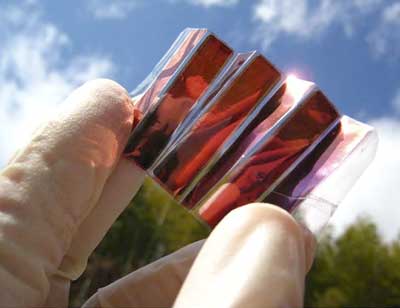| Jan 24, 2019 | |
'Green' electronics made from nanocellulose(Nanowerk News) Imagine folding up a paper-thin computer tablet like a newspaper. Such flexible electronics are moving closer to reality, according to a review in the journal Science and Technology of Advanced Materials ("Development and applications of transparent conductive nanocellulose paper"). |
|
| Paper that is transparent and conducts electricity could have diverse applications, including foldable computers, transparent touch screens and even digital camouflage clothing. “With widespread and intensive efforts, low-cost and lightweight ‘green’ electronics fabricated on transparent nanopaper substrate will provide new technologies impacting our daily life,” state the review paper authors from Nanyang Technological University in Singapore. | |
| Cellulose, the building block of paper taken from plants, is an exciting alternative to the plastic, glass and silicon that currently make up most electronic devices, including computers and mobile phones. Cellulose is renewable, biodegradable, strong and lightweight. For the past 30 years, scientists have considered ways to combine the smallest plant fibres, called ‘nanocellulose’, with electronics. | |
 |
|
| Portable solar cells based on foldable, lightweight, transparent, conductive cellulose nanofibre paper. (Image: CC-BY Macmillan Publishers Ltd) | |
| For example, researchers at Nanyang Technological University have made nanopaper out of nanocellulose and silver nanowires. It still conducts electricity after being folded in half 500 times. Some nanopapers have reached 90% transparency, while others are in the 80% range similar to plastic. | |
| But, better than plastic, nanopapers degrade quickly. After metal electrodes are removed, nanopaper can be buried in soil and will fully degrade within a month. However, this benefit is also a challenge: researchers are working on ways to prevent premature degradation. If they can solve this as well as bring down production costs, electronics could soon be built from plants. | |
Preventing the ‘coffee ring’ effect |
|
| Nanocellulose can also enhance ink and printed electronics, which are produced much like printed words, by helping particles disperse evenly rather than spread apart. | |
| Drying is an important part of printing words and electronics. Particles suspended in liquid are applied to a surface and the liquid evaporates leaving the particles behind. Often, the particles dry unevenly because of the so-called ‘coffee ring effect’. Particles tend to move to the outside of the liquid droplet, similar to the hollow rings left by dried, spilled coffee. | |
| Uneven drying is a problem: it reduces conductivity of printed electronics, accelerates degradation of paint coatings, and makes printed characters on paper fuzzier. Cellulose nanofibres offer a sustainable and effective way to ensure even drying, according to another paper published in Science and Technology of Advanced Materials ("Suppressing the coffee-ring effect of colloidal droplets by dispersed cellulose nanofiber"). | |
| Research by Tokyo University of Agriculture and Technology and Nagoya University found that liquids with nanofibres dried much more evenly than those without. Instead of a hollow ring, the particles condensed into a solid dot, slightly shrinking in size as the liquid evaporated. Particles in the mixtures with nanofibres also moved at a consistent pace. There was no final rush to the periphery as was observed in liquids without nanofibres. | |
| Further investigation is required to determine how the nanofibres, which remain after drying, affect material performance. “The addition of cellulose nanofibres may alter the electrical resistivity of conductive wires in the printed electronics, but the fine-tuning of the concentration might be exploited for the control of electric resistivity itself,” the researchers conclude. |
| Source: Nanyang Technological University | |
|
Subscribe to a free copy of one of our daily Nanowerk Newsletter Email Digests with a compilation of all of the day's news. |
